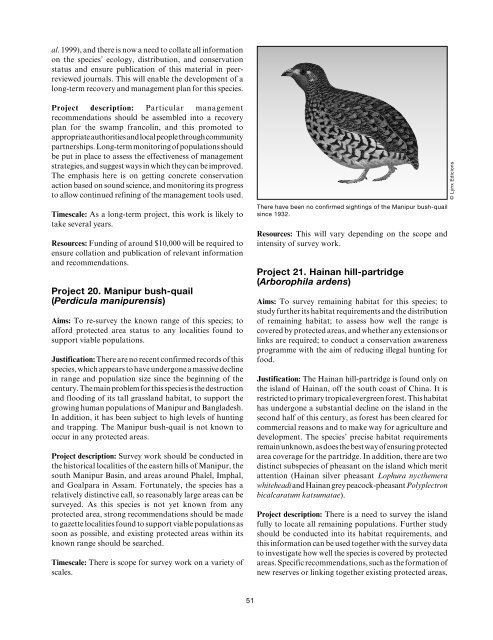Partridges, Quails, Francolins, Snowcocks, Guineafowl, and Turkeys
Partridges, Quails, Francolins, Snowcocks, Guineafowl, and Turkeys
Partridges, Quails, Francolins, Snowcocks, Guineafowl, and Turkeys
Create successful ePaper yourself
Turn your PDF publications into a flip-book with our unique Google optimized e-Paper software.
al. 1999), <strong>and</strong> there is now a need to collate all information<br />
on the species’ ecology, distribution, <strong>and</strong> conservation<br />
status <strong>and</strong> ensure publication of this material in peerreviewed<br />
journals. This will enable the development of a<br />
long-term recovery <strong>and</strong> management plan for this species.<br />
Project description: Particular management<br />
recommendations should be assembled into a recovery<br />
plan for the swamp francolin, <strong>and</strong> this promoted to<br />
appropriate authorities <strong>and</strong> local people through community<br />
partnerships. Long-term monitoring of populations should<br />
be put in place to assess the effectiveness of management<br />
strategies, <strong>and</strong> suggest ways in which they can be improved.<br />
The emphasis here is on getting concrete conservation<br />
action based on sound science, <strong>and</strong> monitoring its progress<br />
to allow continued refining of the management tools used.<br />
Timescale: As a long-term project, this work is likely to<br />
take several years.<br />
Resources: Funding of around $10,000 will be required to<br />
ensure collation <strong>and</strong> publication of relevant information<br />
<strong>and</strong> recommendations.<br />
Project 20. Manipur bush-quail<br />
(Perdicula manipurensis)<br />
Aims: To re-survey the known range of this species; to<br />
afford protected area status to any localities found to<br />
support viable populations.<br />
Justification: There are no recent confirmed records of this<br />
species, which appears to have undergone a massive decline<br />
in range <strong>and</strong> population size since the beginning of the<br />
century. The main problem for this species is the destruction<br />
<strong>and</strong> flooding of its tall grassl<strong>and</strong> habitat, to support the<br />
growing human populations of Manipur <strong>and</strong> Bangladesh.<br />
In addition, it has been subject to high levels of hunting<br />
<strong>and</strong> trapping. The Manipur bush-quail is not known to<br />
occur in any protected areas.<br />
Project description: Survey work should be conducted in<br />
the historical localities of the eastern hills of Manipur, the<br />
south Manipur Basin, <strong>and</strong> areas around Phalel, Imphal,<br />
<strong>and</strong> Goalpara in Assam. Fortunately, the species has a<br />
relatively distinctive call, so reasonably large areas can be<br />
surveyed. As this species is not yet known from any<br />
protected area, strong recommendations should be made<br />
to gazette localities found to support viable populations as<br />
soon as possible, <strong>and</strong> existing protected areas within its<br />
known range should be searched.<br />
Timescale: There is scope for survey work on a variety of<br />
scales.<br />
There have been no confirmed sightings of the Manipur bush-quail<br />
since 1932.<br />
Resources: This will vary depending on the scope <strong>and</strong><br />
intensity of survey work.<br />
Project 21. Hainan hill-partridge<br />
(Arborophila ardens)<br />
Aims: To survey remaining habitat for this species; to<br />
study further its habitat requirements <strong>and</strong> the distribution<br />
of remaining habitat; to assess how well the range is<br />
covered by protected areas, <strong>and</strong> whether any extensions or<br />
links are required; to conduct a conservation awareness<br />
programme with the aim of reducing illegal hunting for<br />
food.<br />
Justification: The Hainan hill-partridge is found only on<br />
the isl<strong>and</strong> of Hainan, off the south coast of China. It is<br />
restricted to primary tropical evergreen forest. This habitat<br />
has undergone a substantial decline on the isl<strong>and</strong> in the<br />
second half of this century, as forest has been cleared for<br />
commercial reasons <strong>and</strong> to make way for agriculture <strong>and</strong><br />
development. The species’ precise habitat requirements<br />
remain unknown, as does the best way of ensuring protected<br />
area coverage for the partridge. In addition, there are two<br />
distinct subspecies of pheasant on the isl<strong>and</strong> which merit<br />
attention (Hainan silver pheasant Lophura nycthemera<br />
whiteheadi <strong>and</strong> Hainan grey peacock-pheasant Polyplectron<br />
bicalcaratum katsumatae).<br />
Project description: There is a need to survey the isl<strong>and</strong><br />
fully to locate all remaining populations. Further study<br />
should be conducted into its habitat requirements, <strong>and</strong><br />
this information can be used together with the survey data<br />
to investigate how well the species is covered by protected<br />
areas. Specific recommendations, such as the formation of<br />
new reserves or linking together existing protected areas,<br />
© Lynx Edicions<br />
51

















